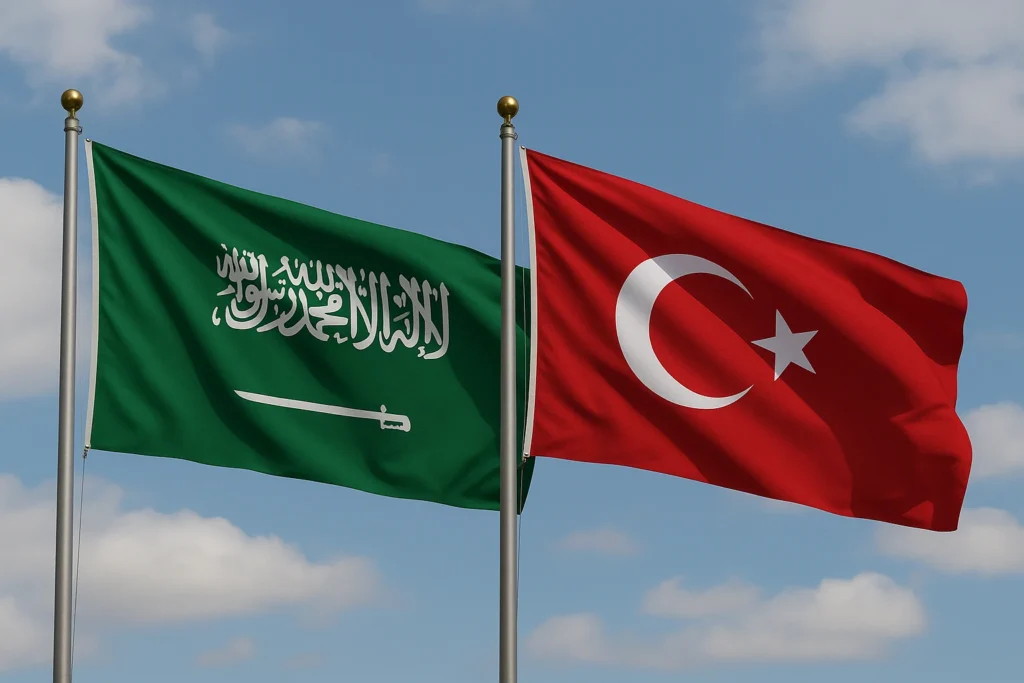Introduction: When Old Rivals Find Common Ground
Imagine a chessboard where the players have been locked in a tense, silent standoff for years. Each move was carefully calculated, often designed to counter the other. This has, in many ways, described the relationship between two major regional powers in the Middle East: Saudi Arabia and Turkey. For years, they often found themselves on opposite sides of conflicts, supporting different groups, and competing for influence across the vast and complex landscape of the Arab world.
But now, a sudden, dramatic shift has occurred. The fall of Bashar Assad’s regime in Syria, a seismic event that reshaped the entire region, has remarkably transformed these long-standing rivals into pragmatic partners. It’s a twist that few predicted, a testament to how quickly alliances can change when the ground beneath your feet shifts. Now, Saudi Arabia and Turkey are cooperating, aiming to stabilize a war-torn Syria and counter shared threats. This isn’t just a small adjustment; it marks a new and potentially defining chapter in Middle Eastern relations. Let’s explore how this unlikely alliance came to be and what it means for the future of a volatile region.
A Region in Flux: The Syria Earthquake
For over a decade, Syria has been the bleeding heart of the Middle East, a land torn apart by civil war, proxy conflicts, and humanitarian catastrophe. At the center of this turmoil was the regime of Bashar Assad, whose survival became a central point of contention and strategy for nearly every regional and global power. His recent fall, after years of clinging to power, is not merely a change of leadership; it’s an earthquake that has sent tremors across the entire geopolitical landscape.
The Impact of Assad’s Fall
The collapse of the Assad regime has created a power vacuum and a completely new set of challenges and opportunities. For countries like Saudi Arabia and Turkey, who had significant stakes in the Syrian conflict, it means a fundamental re-evaluation of their strategies.
- End of a Chapter: For many, Assad’s departure signals the end of a long, brutal chapter in Syrian history, opening possibilities for reconstruction and stability, but also uncertainty.
- Shifting Power Dynamics: The removal of a key player instantly alters the balance of power, forcing everyone to reconsider their alliances and objectives.
- Urgency for Stability: A destabilized Syria remains a source of regional insecurity, extremism, and refugee crises. Both Saudi Arabia and Turkey recognize the urgent need to bring order to the chaos.
This profound change in Syria has acted as a catalyst, forcing nations to put aside past differences and seek common ground where their interests now align.
From Rivals to Reluctant Partners: The Historical Context
To truly appreciate the significance of this new cooperation, it’s vital to understand the historical backdrop of Saudi Arabia and Turkey’s relationship. For decades, their interactions were often characterized by competition rather than collaboration.
Two Regional Giants, Different Visions
- Saudi Arabia: As the leader of the Gulf Cooperation Council (GCC) and home to Islam’s holiest sites, Saudi Arabia traditionally sees itself as the leader of the Sunni Arab world. Its foreign policy has often focused on countering perceived Iranian influence and maintaining regional stability through alliances with Arab states.
- Turkey: Under President Recep Tayyip Erdoğan, Turkey has pursued a more assertive foreign policy, often described as neo-Ottoman, seeking to expand its influence across the former Ottoman lands, including Syria. It has also often prioritized supporting Islamist movements, which sometimes put it at odds with Saudi Arabia’s more conservative, state-centric approach.
Points of Friction
In recent years, several issues fueled their rivalry:
- Syrian Conflict: Turkey supported opposition groups against Assad, while Saudi Arabia, though also anti-Assad, often had different preferred factions and strategic goals.
- Qatar Blockade (2017): When Saudi Arabia, UAE, Bahrain, and Egypt imposed a blockade on Qatar, Turkey strongly sided with Qatar, providing economic and military support, which directly challenged Saudi Arabia’s regional leadership.
- Muslim Brotherhood: Turkey maintained close ties with the Muslim Brotherhood, an organization viewed with suspicion and often outlawed by Saudi Arabia and its allies.
These tensions made direct cooperation seem highly unlikely. The fact that they are now actively working together underscores just how impactful the Syrian shift has been.
The New Reality: Why Cooperation Now?
The fall of Bashar Assad created a geopolitical vacuum that demanded immediate attention. For both Riyadh and Ankara, this new reality presented a critical turning point where their individual interests began to converge more powerfully than their historical disagreements. The question wasn’t just about who would fill the void, but how to prevent even greater chaos. This shared imperative has been the engine behind their pragmatic partnership.
Shared Interests in Syria
With Assad gone, both Saudi Arabia and Turkey now share a common goal: a stable and secure Syria. While their ultimate visions for Syria’s future might still differ in some details, the immediate need to prevent further descent into civil war or the rise of new extremist groups has brought them together.
- Preventing a Vacuum for Extremism: Both nations have suffered from the rise of extremist groups. A power vacuum in Syria could become a breeding ground for new threats, directly impacting their national security.
- Addressing Refugee Crisis: Turkey hosts millions of Syrian refugees, and Saudi Arabia has also been impacted by regional instability. A stable Syria offers the possibility of refugees eventually returning home.
- Countering External Influences: While not explicitly stated, both powers likely see the need to stabilize Syria in a way that limits the influence of other external actors, particularly Iran, who had been a key supporter of the Assad regime. The weakening of Iran’s primary regional ally opens new strategic opportunities.
This pragmatic convergence of interests has allowed both nations to put aside past grievances and focus on the immediate challenges and opportunities presented by a post-Assad Syria.
Stabilizing Syria: The Joint Objectives
With their newfound cooperation, Saudi Arabia and Turkey are now working towards specific goals aimed at bringing stability back to Syria. This involves a multi-faceted approach, focusing on security, governance, and humanitarian efforts in the war-torn country. Their efforts signify a direct attempt to shape Syria’s future after years of internal conflict.
Key Areas of Cooperation
While the full details of their collaborative efforts are still unfolding, their objectives largely revolve around creating conditions for long-term peace:
- Establishing Local Governance: Both nations are likely working with Syrian factions to establish stable, legitimate local governing bodies in areas that were previously under Assad’s control or contested zones. This is crucial for maintaining order and delivering essential services.
- Security Coordination: This might involve coordinating efforts to prevent the resurgence of extremist groups and ensure border security. Turkey has a significant military presence in northern Syria, and Saudi Arabia brings diplomatic and financial leverage.
- Humanitarian Aid and Reconstruction: A stable Syria requires massive humanitarian aid and, eventually, reconstruction efforts. Both countries, as major regional players, are likely to contribute to these efforts, which also serve to build goodwill and stability.
- Shaping a Future Syrian State: While avoiding direct intervention in the internal politics of Syria’s new leadership (at least initially), their cooperation aims to create an environment where a more inclusive and representative government can eventually emerge.
This joint push to stabilize Syria represents a significant pivot from their previous, often conflicting, approaches to the Syrian crisis. It demonstrates a shared recognition that a fractured, unstable Syria poses a greater risk to their own security than their historical differences.
Countering Shared Threats: Beyond Syria’s Borders
The alliance between Saudi Arabia and Turkey extends beyond just the immediate challenge of stabilizing Syria. The fall of Assad has highlighted and, in some cases, intensified other regional threats that both nations perceive as dangerous to their long-term interests. This shared concern about wider regional instability is a powerful glue for their newfound cooperation.
A Focus on Regional Security
- Iranian Influence: For both Saudi Arabia and Turkey, the influence of Iran in the Middle East has been a significant concern. While their strategies to counter it have differed in the past, the weakening of Iran’s main regional ally (Assad’s Syria) creates an opportunity for them to work together to limit further Iranian expansion and strengthen alternative regional balances.
- Extremist Groups: The chaotic aftermath of the Syrian conflict created fertile ground for various extremist and terrorist groups. Both Riyadh and Ankara are acutely aware of the threat these groups pose to their domestic and regional security. Their cooperation aims to prevent these groups from re-establishing strongholds in a new, fluid Syrian landscape.
- Regional Stability: Ultimately, both countries have a vested interest in a stable and prosperous Middle East. Prolonged conflicts, proxy wars, and humanitarian crises destabilize the entire region, impacting trade, investment, and security. By working together, they aim to foster a more predictable and secure regional environment.
This focus on countering shared threats provides a strong strategic rationale for their alliance, suggesting that their cooperation is not merely opportunistic but driven by deeper, long-term security concerns that transcend their past rivalries.
The Ripple Effect: Implications for the Broader Middle East
The emerging alliance between Saudi Arabia and Turkey is not just a bilateral development; it’s a major geopolitical event with significant implications for the broader Middle East. This shift could redraw lines of influence, create new power blocs, and fundamentally alter how other regional and global players approach the region.
A New Regional Dynamic
- Shifting Balances of Power: For years, the Middle East has been characterized by various rivalries and alliances. The Saudi-Turkey alliance could create a new axis of influence, potentially challenging existing dynamics, particularly those involving Iran and other states.
- Impact on Other Actors: Countries like Egypt, Jordan, and Iraq will be watching closely, as this alliance could affect their own security and economic interests. It might prompt them to re-evaluate their own foreign policy alignments.
- Global Superpowers: Major global players like the United States, Russia, and China will also need to adjust their strategies in the Middle East in response to this new alignment. It could change how they engage with the region and which partners they prioritize.
This development underscores the fluid nature of Middle Eastern geopolitics. What was once a fixed rivalry has given way to a pragmatic partnership, driven by immediate necessities and shared long-term interests. The new chapter in regional relations initiated by this alliance promises to reshape the political landscape of the Middle East in ways that are only just beginning to unfold.
Challenges and Opportunities on the Road Ahead
While the new alliance between Saudi Arabia and Turkey is a significant development, it’s important to recognize that it’s a pragmatic partnership born out of necessity, not necessarily a deep ideological alignment. This means there will be both considerable challenges and substantial opportunities on the road ahead.
Hurdles to Overcome
- Lingering Distrust: Decades of rivalry and competing interests mean that a degree of distrust might linger beneath the surface. Building deep, lasting trust will take time and consistent cooperation.
- Differing Long-Term Visions: While their immediate goals in Syria align, their long-term visions for Syria and the broader region might still differ in certain aspects, which could lead to future disagreements.
- Internal Pressures: Both governments face their own domestic political and economic pressures that could, at times, impact their foreign policy decisions and commitment to the alliance.
- External Reactions: The alliance will be viewed with suspicion by some regional and global actors, potentially leading to counter-alliances or efforts to undermine their cooperation.
Pathways for Success
Despite the challenges, the opportunities for success are compelling:
- Enhanced Regional Stability: If successful, their cooperation in Syria could set a precedent for addressing other regional conflicts and fostering greater stability.
- Economic Benefits: Greater cooperation could lead to increased trade and investment between two of the region’s largest economies, benefiting both nations.
- Stronger Regional Voice: A unified front on key regional issues could give Saudi Arabia and Turkey a stronger, more influential voice in international forums.
The success of this alliance will depend on their ability to manage their lingering differences, stay focused on shared objectives, and adapt to the ever-changing dynamics of the Middle East.
Conclusion: A New Era of Pragmatism in the Middle East
The fall of Bashar Assad’s regime in Syria has indeed ushered in a dramatic and unexpected era in Middle Eastern geopolitics, transforming the once-rivalrous relationship between Saudi Arabia and Turkey. This shift from competition to pragmatic partnership is a powerful testament to how rapidly regional dynamics can change when faced with new realities and shared imperatives.
Now, both nations are actively cooperating to stabilize Syria and counter shared threats, recognizing that a chaotic Syria poses a greater risk than their past disagreements. This new chapter in regional relations holds immense implications, potentially reshaping alliances, influencing power balances, and setting a precedent for a more pragmatic approach to foreign policy in the Middle East. While challenges remain, the convergence of their interests in a post-Assad world suggests that this unlikely alliance could be a defining feature of the region’s future, striving for stability amidst continued transformation.




yw5npl